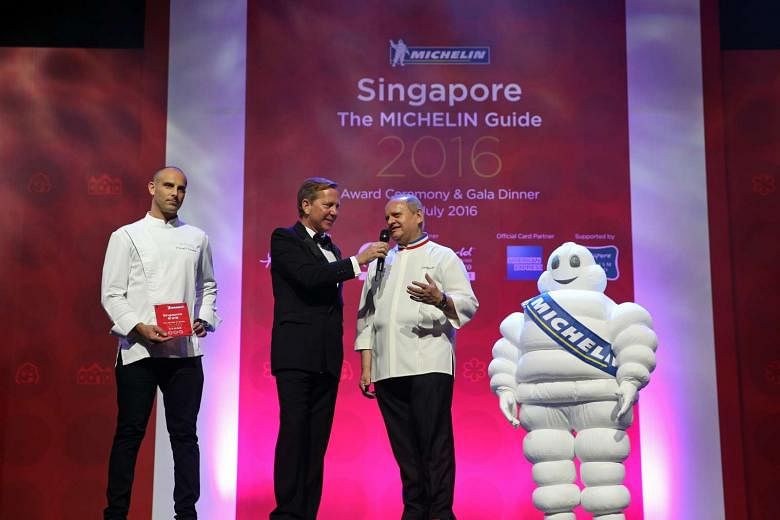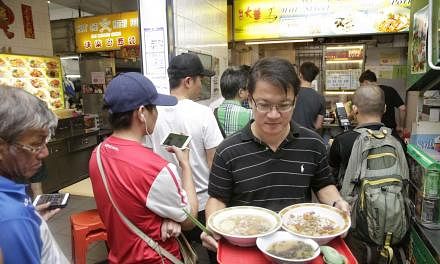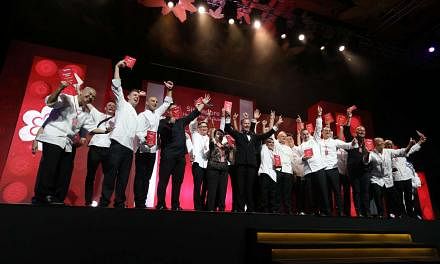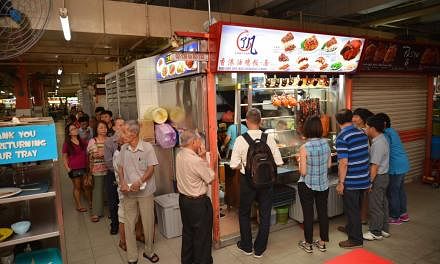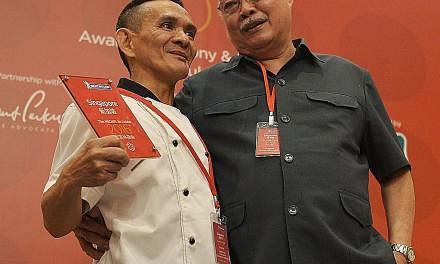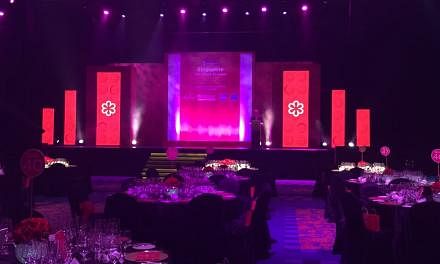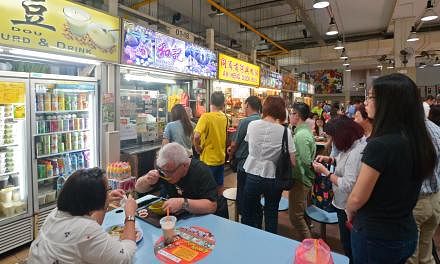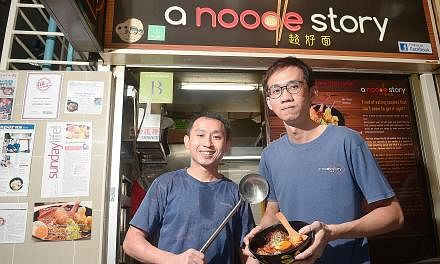As with every restaurant guide, the inaugural edition of the Singapore Michelin Guide will meet with incredulity that one's favourite restaurant was not included, or surprise that another one was.
Having dined at almost all the eateries awarded stars - the exceptions being Shoukouwa in One Fullerton, Terra in Tras Street and Hong Kong Soya Sauce Chicken Rice & Noodle in Chinatown - I find the guide's assessment to be pretty much on the mark.
At a talk during the Singapore Coffee Festival last month, I predicted that Joel Robuchon Restaurant in Resorts World Sentosa would get the maximum three stars - which it did, the only Singapore restaurant given that honour.
The French restaurant had been left out of other prominent lists such as Asia's 50 Best Restaurants and was probably one of the most under-rated fine-dining eateries here.
I have enjoyed the restaurant's refined, exquisite cooking at every one of my visits over the past five years. Just the bread trolley alone, with its amazing range, is worth a star on its own.
The dining room is also lovely, with a Baccarat crystal chandelier and a vertical garden wall. And the service is certainly of international fine-dining standards.
Other restaurants that I am happy to see in the guide are Odette at National Gallery Singapore, Les Amis at Shaw Centre and Restaurant Andre in Bukit Pasoh Road, which all received two stars.
Some one-star restaurants too are totally deserving of the accolade - The Kitchen at Bacchanalia in HongKong Street, Crystal Jade Golden Palace in Paragon Shopping Centre and Jaan in Swissotel The Stamford.
But there are also a number of inclusions I find puzzling.
Much as I like Joel Robuchon Restaurant, I find its sister restaurant, the more casual L'Atelier de Joel Robuchon, located next door, rather underwhelming.
It's a decent restaurant, but hardly deserving of the two stars it received. In fact, I cannot remember any dish I've eaten there other than a beef fillet that was tender, but not very flavourful.
And Shoukouwa in One Fullerton, which soft-opened quietly in March and received little buzz among foodies here, was a total surprise. I have not dined there, so I can't say if it deserves its two stars. But it does appear as if the Michelin inspectors, none of whom are from Singapore, went out of their way to award it the stars.
Tastings for the Singapore guide ended in May and Michelin's rules are that each restaurant has to be assessed separately by at least three or four inspectors.
So to meet the deadline, it would seem the inspectors flew here in a hurry to dine at Shoukouwa just after it opened. What prompted such interest in the restaurant that they couldn't wait to include it in next year's edition instead?
When I asked Mr Michael Ellis, the international director of Michelin Guides, after the launch, he could not quite say either, except that it was "probably because of the network of Japanese inspectors".
But what, for me, was treated most unfairly is Waku Ghin in Marina Bay Sands. Not because it received one star, but that it deserves at least two.
I find the restaurant, helmed by celebrated Sydney chef Tetsuya Wakuda, one of the best, if not the best, restaurants in Singapore.
It certainly more than meets almost all the criteria set by the Michelin Guide - quality of ingredients, skill in their preparation and the combination of flavours, level of creativity, value for money and consistency of culinary standards.
The only criteria it does not meet is perhaps value for money, as a meal there costs $400 a person. But even that is debatable when you consider the quality of the ingredients, many of which are imported from Japan and top-notch. In comparison, Shoukouwa charges up to $480 a person.
A Japanese restaurant that I hope to see included in next year's edition is Hashida Sushi. For me, it is definitely in the league of top sushi restaurants here and its exclusion is puzzling when another restaurant of similar standards, such as Sushi Ichi (one star) at Marriott Tang Plaza Hotel, is included.
I'm happy to see local chefs such as Jason Tan from Corner House in the Botanic Gardens getting a star. His modern European cooking is creative, beautifully plated and, most importantly, delicious. And every menu is as good as the last one, a feat that not many chefs can achieve.
This is one entry I expect to see collecting more stars in the coming years.
But Candlenut (also one star), which is helmed by another local boy, Malcolm Lee, is not a restaurant I would choose to represent good Peranakan cooking.
I gave it a mixed review when it opened in Dorsett Hotel in 2013 and returned last week after learning that it was invited to the Michelin Guide launch - which meant it would get at least one star.
The cooking had certainly improved from three years ago, but dinner is now a fixed-price menu at $65 a person.
My dessert of Buah Keluak Ice Cream carried a supplement of $5, so my meal cost $70, not including service charge and tax. My a la carte dinner in 2013 cost about $40 a person.
Portions for the set were tiny, with just one piece for each person of items such as kueh pie tee, satay and snapper fillet. I was only three-quarters full after the dinner.
I loved some of the dishes, such as the Pong Tahu Soup, which was a full-bodied shellfish bisque with a succulent tofu and crab meatball that was excellent.
The Homemade Kueh Pie Tee with blue swimmer crab, yellow curry and laksa leaf was also a departure from traditional recipes that worked very well. The combination of flavours hit the spot with every bite.
But there were also dishes that failed. The Blackmore Wagyu Beef Satay boasted tender, tasty meat, but the gravy spooned over it was underseasoned and bland.
The shelled prawns in the Tiger Prawn Lemak Nanas were overcooked, tough and juiceless.
And the Buah Keluak Ice Cream was interesting - just as an unusual ice-cream flavour such as truffle or black garlic would be. But I certainly have no craving to eat it again.
Is Candlenut the best Peranakan restaurant in Singapore?
I think chef Malcolm Lee is doing a good job and has the potential and passion to be a top chef. But right now, there are better restaurants I would choose to represent Singapore cuisine.
Restaurateur and chef Violet Oon owns two of them - Violet Oon Restaurant in Bukit Timah Road, which serves Peranakan food, and National Kitchen in the National Gallery Singapore, which showcases Singapore cuisine primarily from the Peranakan, Eurasian and Indian communities.
Their dishes, such as Buah Keluak Spaghetti and Bubur Chacha Pannacotta, are no less creative than what you would find at Candlenut. But what makes them better restaurants is that you do not find dishes with major problems such as overcooking or blandness.
I can't wait to see next year's edition of the guide. Hopefully, it will have a fuller list because Singapore definitely has many more good eateries than the 29 included this year.

